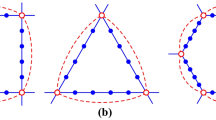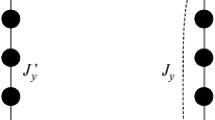Abstract
The Ising model on a square lattice with arbitrary number of decorating spins, considering both the interactions between nodal and decorating spins is examined. A plethora of peculiarities such as heat capacity splitting, generation and suppression of multiple phase transitions and several kinds of partial ordering are thoroughly scrutinized. A rigorous analytical expression for the partition function closely resembling the one obtained by Onsager is presented.








Similar content being viewed by others
REFERENCES
L. Onsager, “Crystal statistics. I. A two-dimensional model with an order–disorder transformation,” Phys. Rev. 65, 117–149 (1944).
R. M. F. Houtappel, “Order–disorder in hexagonal lattices,” Physica 16, 425–455 (1950).
G. H. Wannier, “Antiferromagnetism. The triangular Ising net,” Phys. Rev. 79, 357–364 (1950).
K. Kanô and S. Naya, “Antiferromagnetism. The kagomé Ising net,” Prog. Theor. Phys. 10, 157–172 (1953).
D. P. Landau and K. Binder, A Guide to Monte-Carlo Simulations in Statistical Physics (Cambridge University Press, Cambridge, 2009.
A. K. Murtazaev, M. K. Ramazanov, and M. K. Badiev, “Critical properties of the two-dimensional Ising model on a square lattice with competing interactions,” Phys. B: Condens. Matter 476, 1–5 (2015).
H. T. Diep, Frustrated spin systems (World Scientific, Singapore, 2013).
F. Y. Wu, “The Potts model,” Rev. Mod. Phys. 54, 235–268 (1982).
I. Syozi and S. Miyazima, “A statistical model for the dilute ferromagnet,” Prog. Theor. Phys. 36, 1083–1094 (1966).
M. Fisher, “Transformations of Ising models,” Phys. Rev. 113, 969–981 (1958).
M. Jaščur, V. Štubňa, K. Szalowski, and T. Balcerzak, “Frustration in an exactly solvable mixed-spin Ising model with bilinear and three-site four-spin interactions on a decorated square lattice,” J. Magn. Magn. Mater. 417, 92–99 (2016).
L. Čanova, J. Strečka, and M. Jaščur, “Exact results of the mixed-spin Ising model on a decorated square lattice with two different decorating spins of integer magnitudes,” Int. J. Mod. Phys. B 22, 2355–2372 (2008).
R. J. Baxter, Exactly Solved Models in Statistical Mechanics (Academic, New York, 1982).
H. A. Kramers and G. H. Wannier, “Statistics of the two-dimensional ferromagnet. Part I,” Phys. Rev. 60, 252–262 (1941).
F. A. Kassan-Ogly and A. I. Proshkin, “Frustrations and ordering in magnetic systems of various dimensions,” Phys. Solid State 60, 1090–1097 (2018).
I. Syozi, “A decorated Ising lattice with three transition temperatures,” Prog. Theor. Phys. 39, 1367–1368 (1968).
F. A. Kassan-Ogly, B. N. Filippov, A. K. Murtazaev, M. K. Ramazanov, and M. K. Badiev, “Influence of field on frustrations in low-dimensional magnets,” J. Magn. Magn. Mater. 324, 3418–3421 (2012).
J. F. Counsell, R. M. Dell, A. R. Junkison, and F. F. Martin, “Thermodynamic properties of uranium compounds,” Trans. Faraday Soc. 63, 72–79 (1966).
A. Blaise, R. Lagnier, J. E. Gordon, and R.Troc, “Heat capacity studies of ThP and UP0.5As0.5 solid solution. Reanalyzing UP data,” J. Low-Temp. Phys. 61, 323–335 (1985).
H. Yokokawa, Y. Takahashi, and T. Mukaibo, “The heat capacity of uranium monophosphide from 80 to 1080 K and the electronic contribution,” in Thermodynamics of Nuclear Materials 1974, Vol. II (Int. Atomic Energy Agency, Vienna, 1975), pp. 419–430.
A. Blaise, R. Troc, R. Lagnier, and M. J. Mortime, “The heat capacity of uranium monoarsenide,” J. Low. Temp. Phys. 38, 79–92 (1980).
Funding
The research was carried out within the state assignment of Minobrnauki of Russia (theme “Quantum” no. AAAA-A18-118020190095-4), supported in part by Ural Branch of the Russian Academy of Sciences (project no. 18-2-2-11).
Author information
Authors and Affiliations
Corresponding author
Rights and permissions
About this article
Cite this article
Proshkin, A.I., Kassan-Ogly, F.A. Frustration and Phase Transitions in Ising Model on Decorated Square Lattice. Phys. Metals Metallogr. 120, 1366–1372 (2019). https://doi.org/10.1134/S0031918X19130234
Received:
Published:
Issue Date:
DOI: https://doi.org/10.1134/S0031918X19130234




